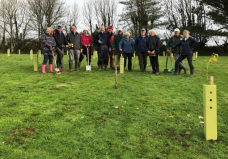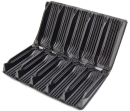There is a nationwide push to plant more trees and Parishes and Community groups around the country have been actively doing so with the help of various organisations such as the Woodland Trust. 
Trees whips planted with supports and protectors Photo Peter Brown
However, there is a shortage of tree seedlings and whips so communities are being encouraged to grow their own trees!
Yealm Estuary to Moor (YEM) Wildlife Corridor Project involves creating more natural spaces along the river catchment including planting trees. We are therefore working with community groups along the river Yealm (Newton and Noss, Wembury, Brixton, Yealmpton, Cornwood and Sparkwell) to grow trees ahead of needing tree samplings and whips to plant out. We are only need native species to be brought on and planted and we are hoping to get schools involved.

It starts with a seed. We are therefore asking for help with collecting tree seed (eg fruit, nuts and bracts) now, this Autumn. Gathering seeds with family, friends or colleagues is a great way to spend time outdoors and can make a difference. It is a good time to collect seed from Rowan, Hazel, Silver Birch and Hawthorn in September and Blackthorn, crab apple, alder and oak in October. There are a lot of good tips on seed gathering and seed identification guides (see below). Husks need to be removed from nut seeds (if they sink in a bucket of water they are more likely to germinate), and berries need to have the flesh removed before over wintering).

Growing a tree seedling is something that everybody can do. Whilst YEM is happy to take your collected seeds/berries you collect you may want to germinate the seedlings yourself first, and let us have the ones that do so successfully. Seeds such as oak & hazel can be planted immediately into trays or troughs using a mix of compost and vermiculite and keep outside over winter protected from mice, frost and direct sun (fine greenhouse mesh will suffice). Water as necessary, but avoid waterlogging. Alternatively overwinter the seeds in a fridge.

Once the first true leaves appear the plants can be transferred into root trainers (YEM has some root trainers if needed) or pots or taken to the local tree nursery (contacts listed below).
Other seeds may require a cool storage over winter before planting. Again, there is a lot of guidance available for you to consider (see Further Guidance and advice below) including that seeds to grow and how to nurture and protect your seeds and seedlings.
Growing on a tree seedling on to whips. Once you have some seedlings you can grow them on in large pots or YEM can help by taking planting the seedlings in one of our tree nurseries. The seedlings should then be grown on for 2 or 3 years when they will be ready to be planted in their final positions.
 Planting out in and cover with mesh over plastic hoops to keep mice and birds from eating
them ! (Photos DWT)
Planting out in and cover with mesh over plastic hoops to keep mice and birds from eating
them ! (Photos DWT)
Whilst YEM has some Tree Nurseries ready to take seeds or seedlings, we are encouraging more to be established by community groups along the river. Alternatively, if you have the space you can build your own raised bed/tree nursery. Information on building a tree nursery is available as a separate YEM guide.
Further Guidance and Advice:
The Conservation Volunteers (TCV) - website and handbook
The Tree Council - seed collecting and how to get funding
The Woodland Trust - tree identification and free trees for communities
Devon Wildlife Trust (DWT) Tree Nursery Guidance and Tree Planting Guide